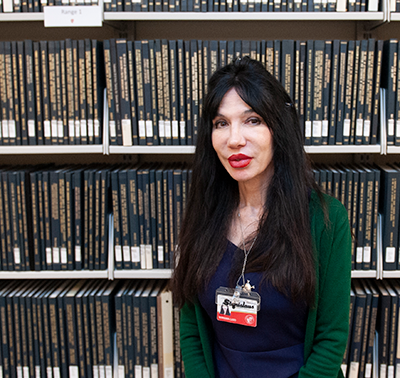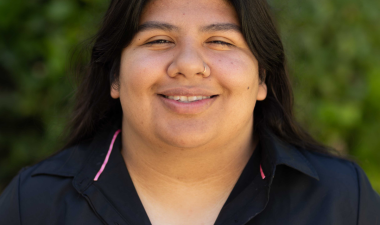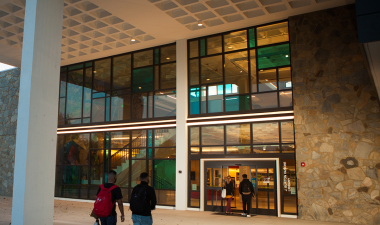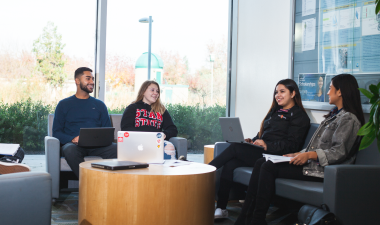A book signed by Abraham Lincoln before he became president of the United States, diaries of early California pioneers and thousands of photographs of early life in the San Joaquin Valley are among the treasures in the Stanislaus State Vasché Library Special Collections and University Archives (SCUA).
Housed on the third floor of the Library, the permanent collection allows visitors to glimpse the formation of California and Stanislaus County. It includes pieces from the 17th, 18th and 19th centuries.
SCUA is a repository for primary research materials, which are original first-hand accounts, which may be of interest to not only students, faculty and staff, but also the community and beyond.
The Special Collections is comprised of rare books and local history, whereas the University Archives document the history of Stan State.
The University Archives

The historic archives provide an opportunity to see how campus life and pioneers in the Central Valley existed in the 20th century. It includes campus publications such as newsletters, catalogs, press releases, photographs, the Signal student newspaper and campus yearbooks, as well as other documents. The number of volumes illustrating the history of Turlock, Stanislaus County, and the Central Valley region is approximately 1,100.
Stan State Archivist Mary Weppler-Van Diver, with the assistance of several students, is currently in the process of digitizing the archives to better protect them and make them available to a worldwide audience. Currently, the students are digitizing the Signal student newspaper so past editions can be accessed online.
“This is a big endeavor and will be beneficial for people to read about what was going on here decades ago,” Weppler-Van Diver said. “This offers a glimpse of student perspectives through time.”
The archives are stored in optimal conditions, which includes controlling the humidity in the room. If an item is damaged, Weppler-Van Diver delicately repairs it in the Library’s restoration room.
A love of history and preserving the past stems back to childhood for Weppler-Van Diver. She recalls cherishing her grandmother’s old photo albums. That same care has trickled down throughout her life and led her into her chosen path.
“Things need to be saved, and if you don’t care for them, they will go away,” she said. “That was the driving principle throughout my life.”
She worked as an archivist and in the library at UC Merced for more than a decade and has worked at Stan State since 2021. Weppler-Van Diver has two master’s degrees; she studied art at Sacramento State, earning a Master of Arts in Art History and a master’s in library science from the University of Arizona. Additionally, she is a certified archivist through the Academy of Certified Archivists and has a graduate certificate in digital information management.
She is using her background to curate the extensive collections. There are collections of oral history interviews dating back to the 1980s, audiovisual materials and campus photographs. Additionally, the archives hold an archival copy of each Stanislaus State graduate’s thesis.
“The archives are where history comes alive,” Stan State Dean of Library Services Ron Rodriguez said. “It’s a place where people’s personal lives and the tangible items of their lives come together as a testament to what they saw, did or created.”
The Special Collections
Illustrating the history of Turlock, Stanislaus County and the Central Valley region, the Special Collections has approximately 1,000 volumes. There are many early printed books dating back to the 17th century and recent titles of special interest to researchers of California and local history.
Smaller collections of poetry, tiny books, art volumes and periodicals round out the collection. More than 260 digitized historical photographs and images of a Turlock commemorative scrapbook are also searchable online. Additionally, there are 3,400 digital objects across the collections, many of which have been digitized just in the past two and a half years.
Both donated and purchased collections make up the Special Collections. The main purpose of Special Collections is to support faculty teaching and student learning and research, although it is so much more.
“People from all over the world use the Special Collections and University Archives now that some of it has been digitized,” Weppler-Van Diver, said. “It is exciting that so many people can now access the archives. We really want to make it accessible to everyone.”
She wants people to know that it is available and not to be intimidated by it.
Rare and local history titles are included in the Library catalog and may be requested and read in the Special Collections Reading Room by appointment. There is a wide variety of collections relevant to disciplines taught at Stan State. University primary source materials make up the collection, which includes journals, memoirs and interviews, as well as publications, local and regional history books and documents, local history manuscript collections, oral histories, Stanislaus County historical documents and photographic collections.
Some of the gems that can be found:
The Sayad Assyrian Collection
One of the older and most popular collections is the Sayad Assyrian Collection, which consists of the Assyrian book collection of the Rev. Eshoo Paul Sayad of Turlock. Acquired by the Stan State Library in 1970, it includes rare books about Assyrian religion and culture, from its early beginnings in the ancient civilizations of Mesopotamia to modern times in Northwestern Iran. The collection consists of 231 books, with more than 100 books in Syriac (with some English translations), as well as books in English and other languages.
“Turlock is a vital center of Assyrian culture, so it may not be surprising that this is one of the most popular collections,” Weppler-Van Diver said.
More than 50 interviews with local Assyrians have been converted from tape to MP3 to both preserve them and to allow greater access. The collection is searchable in the University Library Catalog.
The Nisaburo Aibara Collection
The Nisaburo Aibara Collection features materials from the Turlock Social Club, a local Japanese American community group active between 1939 and 1970. There are documents from the Japanese American Citizens League and those related to the Stockton, Turlock and Merced Assembly Centers, created in 1942 with the enactment of President Franklin Delano Roosevelt’s Executive Order 9066, which would send Japanese Americans to concentration camps in the wake of the attack on Pearl Harbor. The collection also features correspondence with reactions, responses and preparations for the 1942 mass evacuation launched by Roosevelt’s Executive Order. Additionally, the collection has records on the Central California Cantaloupe Company, Turlock Farm Corporation, Turlock Japanese Society and family records and funeral service programs of Japanese American residents of Turlock. There were 58 items from this collection digitized for the California State University Japanese American History Digitization Project.
The Dias Photographic Collection
There are two collections featured throughout the year in the Special Collections Reading Room. Currently featured is the Manuel Peixoto Dias Photographic Collection of the 20th Century, comprising more than 30,000 photographic prints, slides and negatives taken by professional photographer Manuel Peixoto Dias. Dias worked for the Modesto Bee and the Stanislaus County Office of Education as an aerial photographer while also maintaining a private photography business in Modesto.
“I really enjoy putting the exhibits together and sharing them with the public,” Weppler-Van Diver said. “It is a great way to get people interested.”
The Historic Newspaper Collection
Print newspapers dating back to the 1870s — including early Stanislaus County newspapers Tuolumne City News and The Stanislaus County Weekly News — make up this collection along with several precursor titles of the modern-day Modesto Bee.
It also includes an early print run of the Sacramento Reporter, together with early newspaper runs representing several Stanislaus County towns and villages, including Ceres, Hughson and Denair. A full archive of The Turlock Journal and its predecessor titles is available on microfilm in the periodicals stacks of the Library. The condition of the papers ranges from excellent to very fragile.
“I encourage anyone interested in the history of the local area, in the history of California or the nation, to visit Special Collections and University Archives,” Rodriguez said. “There is literally a treasure chest of items.”


